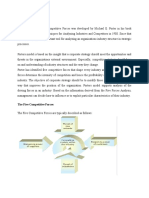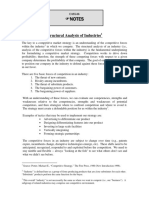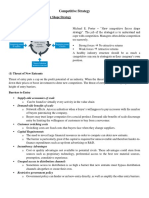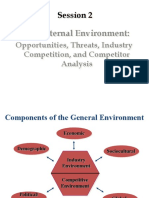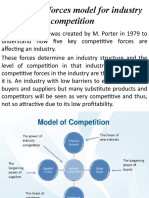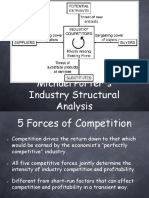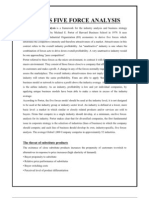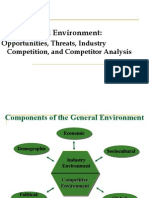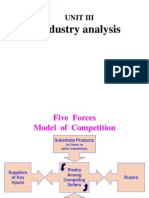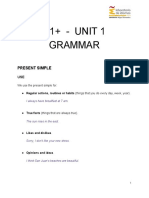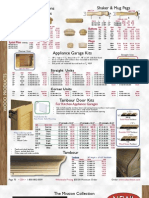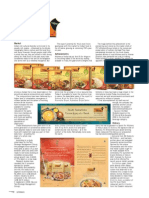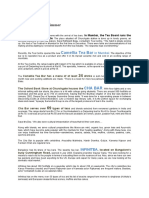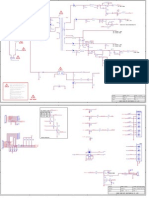0 ratings0% found this document useful (0 votes)
6 viewsTemplate For Doing A Five Forces Analysis
Template For Doing A Five Forces Analysis
Uploaded by
lehouxmanon152This document provides a template for conducting a five forces analysis to evaluate the competitive environment of an industry. It includes factors to characterize the degree of rivalry among existing competitors, the threat of new entry, the pressure from substitute products and complements, and the bargaining power of suppliers and buyers. For each factor, companies would assess the current characterization and future trends to understand how these forces impact profitability.
Copyright:
© All Rights Reserved
Available Formats
Download as PDF, TXT or read online from Scribd
Template For Doing A Five Forces Analysis
Template For Doing A Five Forces Analysis
Uploaded by
lehouxmanon1520 ratings0% found this document useful (0 votes)
6 views5 pagesThis document provides a template for conducting a five forces analysis to evaluate the competitive environment of an industry. It includes factors to characterize the degree of rivalry among existing competitors, the threat of new entry, the pressure from substitute products and complements, and the bargaining power of suppliers and buyers. For each factor, companies would assess the current characterization and future trends to understand how these forces impact profitability.
Original Description:
template for doing a five force analysis
Original Title
Template for doing a five forces analysis
Copyright
© © All Rights Reserved
Available Formats
PDF, TXT or read online from Scribd
Share this document
Did you find this document useful?
Is this content inappropriate?
This document provides a template for conducting a five forces analysis to evaluate the competitive environment of an industry. It includes factors to characterize the degree of rivalry among existing competitors, the threat of new entry, the pressure from substitute products and complements, and the bargaining power of suppliers and buyers. For each factor, companies would assess the current characterization and future trends to understand how these forces impact profitability.
Copyright:
© All Rights Reserved
Available Formats
Download as PDF, TXT or read online from Scribd
Download as pdf or txt
0 ratings0% found this document useful (0 votes)
6 views5 pagesTemplate For Doing A Five Forces Analysis
Template For Doing A Five Forces Analysis
Uploaded by
lehouxmanon152This document provides a template for conducting a five forces analysis to evaluate the competitive environment of an industry. It includes factors to characterize the degree of rivalry among existing competitors, the threat of new entry, the pressure from substitute products and complements, and the bargaining power of suppliers and buyers. For each factor, companies would assess the current characterization and future trends to understand how these forces impact profitability.
Copyright:
© All Rights Reserved
Available Formats
Download as PDF, TXT or read online from Scribd
Download as pdf or txt
You are on page 1of 5
TEMPLATE FOR DOING A FIVE-FORCES ANALYSIS
FACTORS AFFECTING RIVALRY AMONG EXISTING COMPETITORS
To what extent does pricing rivalry or nonprice competition (e.g.,
advertising) erode the profitability of a typical firm in this industry?
Characterization Future Trend
(Current)
Degree of seller concentration?
Rate of industry growth?
Significant cost differences among firms?
Excess capacity?
Cost structure of firms: sensitivity of costs to capacity
utilization?
Degree of product differentiation among sellers?
Brand loyalty to existing sellers? Cross-price
elasticities of demand among competitors in industry?
Buyers' costs of switching from one competitor to
another?
Are prices and terms of sales transactions observable?
Can firms adjust prices quickly?
Large and/or infrequent sales orders?
Use of "facilitating practices" (price leadership,
advance announcement of price changes)?
History of "cooperative" pricing?
Strength of exit barriers?
High industry price elasticity of demand?
FACTORS AFFECTING THE THREAT OF ENTRY
To what extent does the threat or incidence of entry work to erode the
profitability of a typical firm in this industry?
Characterization Future Trend
(Current)
Significant economies of scale?
Importance of reputation or established brand
loyalties in purchase decision?
Entrants' access to distribution channels?
Entrants' access to raw materials?
Entrants' access to technology /know-how?
Entrants' access to favorable locations?
Experience-based advantages of incumbents?
Network externalities: demand-side
advantages to incumbents from large installed base?
Government protection of incumbents?
Perceptions of entrants about expected retaliation of
incumbents/reputations of incumbents for
"toughness"?
FACTORS AFFECTING OR REFLECTING PRESSURE FROM
SUBSTITUTE PRODUCTS AND SUPPORT FROM COMPLEMENTS
To what extent does competition from substitute products outside the
industry erode the profitability of a typical firm in the industry?
Characterization Future Trend
(Current)
Availability of close substitutes?
Price-value characteristics of substitutes?
Price elasticity of industry demand?
Availability of close complements?
Price-value characteristics of complements?
FACTORS AFFECTING OR REFLECTING POWER OF INPUT
SUPPLIERS
To "what extent do individual suppliers have the ability to negotiate high
input prices with typical firms in this industry? To what extent do input
prices deviate from those that would prevail in a perfectly competitive
input market in which input suppliers act as price takers?
Characterization Future Trend
(Current)
Is supplier industry more concentrated than industry it
sells to?
Do firms in industry purchase relatively small
volumes relative to other customers of supplier? Is
typical firm's purchase volume small relative to sales
of typical supplier?
Few substitutes for suppliers' input?
Do firms in industry make relationship-specific
investments to support transactions with specific
suppliers?
Do suppliers pose credible threat of forward
integration into the product market?
Are suppliers able to price-discriminate among
prospective customers according to ability/
willingness to pay for input?
FACTORS AFFECTING OR REFLECTING POWER OF BUYERS
To what extent do individual buyers have the ability to negotiate low
purchase prices -with typical firms in this industry? To what extent do
purchase prices differ from those that would prevail in a market with a
large number of fragmented buyers in which buyers act as price
takers?
Characterization Future Trend
(Current)
Is buyers' industry more concentrated than the
industry it purchases from?
Do buyers purchase in large volumes? Does a
buyer's purchase volume represent a large fraction
of the typical seller's sales revenue?
Can buyers find substitutes for industry's product?
Do firms in industry make relationship-specific
investments to support transactions with specific
buyers?
Is price elasticity of demand of buyer' s product
high or low?
Do buyers pose credible threat of backward
integration?
Does product represent significant fraction of cost
in buyer's business?
Are prices in the market negotiated between buyers
and sellers on each individual transaction, or do
sellers post a "take-it-or-leave-it" price that applies
to all transactions?
You might also like
- Porter's Five Forces: Understand competitive forces and stay ahead of the competitionFrom EverandPorter's Five Forces: Understand competitive forces and stay ahead of the competitionRating: 4 out of 5 stars4/5 (10)
- Michael Porters Model For Industry and Competitor AnalysisDocument9 pagesMichael Porters Model For Industry and Competitor AnalysisbagumaNo ratings yet
- How Competitive Forces Shape StrategyDocument11 pagesHow Competitive Forces Shape StrategyErwinsyah RusliNo ratings yet
- Consulting Interview Case Preparation: Frameworks and Practice CasesFrom EverandConsulting Interview Case Preparation: Frameworks and Practice CasesNo ratings yet
- Ut ANv Ls Dit DV W0 N MF 353Document5 pagesUt ANv Ls Dit DV W0 N MF 353Tonald DrumpNo ratings yet
- Five Forces AnalysisDocument5 pagesFive Forces Analysiswonderland123No ratings yet
- Sesión 4 - Besanko, D. Economics of Strategy, 2013. Plantilla 5 FuerzasDocument6 pagesSesión 4 - Besanko, D. Economics of Strategy, 2013. Plantilla 5 Fuerzasluis AguirreNo ratings yet
- Porter's Five ForceDocument3 pagesPorter's Five Forcerahul_naidu151No ratings yet
- Applying Michael Porters Five Forces 15091Document22 pagesApplying Michael Porters Five Forces 15091KartikNo ratings yet
- 5 Force ModelDocument14 pages5 Force Modelsrilatha212No ratings yet
- Porter Five ForcesDocument3 pagesPorter Five Forcesshahhazm553No ratings yet
- Porter-Structural Analysis of Industries PDFDocument2 pagesPorter-Structural Analysis of Industries PDFSherry SNo ratings yet
- Porters 5 ForcesDocument3 pagesPorters 5 Forcesjabbimuhammed50No ratings yet
- Porters Five Forces - Content, Application, and CritiqueDocument9 pagesPorters Five Forces - Content, Application, and CritiqueJosé Luís NevesNo ratings yet
- FINAL Midterm Review Guide - Strategy - 2024 - Fall - JSMontesDocument13 pagesFINAL Midterm Review Guide - Strategy - 2024 - Fall - JSMontesdeolivgbNo ratings yet
- Category AnalysisDocument42 pagesCategory AnalysisANJALINo ratings yet
- Business EnvironmentDocument41 pagesBusiness Environmentmilap.parmar.fms24No ratings yet
- Overview of The Five Forces ModelDocument4 pagesOverview of The Five Forces ModelAnuj SrivastavaNo ratings yet
- 5 Forces NotesDocument9 pages5 Forces NotesKshitij LalwaniNo ratings yet
- Approaches To Competitor AnalysisDocument32 pagesApproaches To Competitor AnalysisIsrar Raja100% (1)
- Porter's Five ForcesDocument5 pagesPorter's Five ForcesKris Tina100% (1)
- Bergaining Power of BuyerDocument4 pagesBergaining Power of BuyerrestuNo ratings yet
- Competitive Analysis 1Document25 pagesCompetitive Analysis 1Md.Yousuf AkashNo ratings yet
- Competitive Structure of IndustriesDocument4 pagesCompetitive Structure of IndustriesPooja SheoranNo ratings yet
- Five Forces Model by Michael PorterDocument3 pagesFive Forces Model by Michael PorterDeepika GhoshNo ratings yet
- Industrial and Competitive AnalysisDocument20 pagesIndustrial and Competitive AnalysisPranav PahwaNo ratings yet
- Competitve Forces - Cosmetics IndustryDocument6 pagesCompetitve Forces - Cosmetics IndustryShiblee RahmanNo ratings yet
- 5 - Porter's 5 Force ModelDocument31 pages5 - Porter's 5 Force ModelSunil MauryaNo ratings yet
- The Five Competitive Forces That Shape StrategyDocument14 pagesThe Five Competitive Forces That Shape StrategyronNo ratings yet
- The Five Competitive Forces That Shape StrategyDocument14 pagesThe Five Competitive Forces That Shape StrategyatulpvermaNo ratings yet
- Bmc 312 Intro - Industry AnalysisDocument6 pagesBmc 312 Intro - Industry AnalysisNorhadia OkaNo ratings yet
- Porter's Five Forces Analysis: From Wikipedia, The Free EncyclopediaDocument5 pagesPorter's Five Forces Analysis: From Wikipedia, The Free EncyclopediaSamar MalikNo ratings yet
- Porters 5 ForcesDocument12 pagesPorters 5 ForcesUtakarsh JayantNo ratings yet
- 71 Competitive Environment - Porter's 5 ForcesDocument19 pages71 Competitive Environment - Porter's 5 ForcesGeorge ButlerNo ratings yet
- Porter Five Forces AnalysDocument8 pagesPorter Five Forces Analysasimmba19No ratings yet
- The General, Industry, and Competitor EnvironmentsDocument6 pagesThe General, Industry, and Competitor EnvironmentsUlfa ZhafirahNo ratings yet
- Lecture 2 SMDocument58 pagesLecture 2 SMadil azmiNo ratings yet
- Porter Five Forces Analysis: That Appear in Reliable Third-Party PublicationsDocument8 pagesPorter Five Forces Analysis: That Appear in Reliable Third-Party Publicationsas2624No ratings yet
- Strategic Mgt.Document57 pagesStrategic Mgt.preetimudgalNo ratings yet
- 5 ForceDocument5 pages5 ForceMichael YongNo ratings yet
- 3 - Analysis of External Environment - Industry and CompetitiveDocument37 pages3 - Analysis of External Environment - Industry and CompetitiveRochelle PonnamperumaNo ratings yet
- August 27th Session4Document40 pagesAugust 27th Session4Andrés RedondoNo ratings yet
- Industry AnalysisDocument25 pagesIndustry AnalysisPrashant Tejwani100% (1)
- Porters Five Forces Model For Industry CompetitionDocument15 pagesPorters Five Forces Model For Industry CompetitionShahid ChuhdryNo ratings yet
- Porter's 5 Force ModelDocument4 pagesPorter's 5 Force ModelMai Mgcini BhebheNo ratings yet
- Module 2Document33 pagesModule 2TanishqNo ratings yet
- Michael Porter's Industry Structural AnalysisDocument12 pagesMichael Porter's Industry Structural AnalysisRenell John Maglalang100% (1)
- Competitive Analysis 05Document13 pagesCompetitive Analysis 05Ammarah KhanNo ratings yet
- 5 ForcesDocument42 pages5 Forcesaksr27No ratings yet
- Class #5Document6 pagesClass #5Marcin NasuroNo ratings yet
- A Framework For Industry Analysis: "Five Forces" Model - Michael PorterDocument17 pagesA Framework For Industry Analysis: "Five Forces" Model - Michael Porterkusumawi2311No ratings yet
- Porter's Five ForcesDocument9 pagesPorter's Five ForcesTaVuKieuNhiNo ratings yet
- Environmental Scanning and Industrial AnalysisDocument24 pagesEnvironmental Scanning and Industrial AnalysisHimani TyagiNo ratings yet
- Ranbaxy PorterDocument4 pagesRanbaxy PorterBhanu GuptaNo ratings yet
- Strategic Management NotesDocument46 pagesStrategic Management NotesAccount SpamNo ratings yet
- Porter Five Forces AnalysisDocument3 pagesPorter Five Forces Analysisazazel28No ratings yet
- Porter Five Forces AnalysisDocument5 pagesPorter Five Forces Analysisbhatt_niranjan09No ratings yet
- Porters 5 Forces ModelDocument7 pagesPorters 5 Forces Model2003vishalkypNo ratings yet
- PorterDocument5 pagesPorterVijitha VijayakumarNo ratings yet
- The External Environment:: Opportunities, Threats, Industry Competition, and Competitor AnalysisDocument66 pagesThe External Environment:: Opportunities, Threats, Industry Competition, and Competitor AnalysiskimsrNo ratings yet
- Unit3 Industry AnalysisDocument83 pagesUnit3 Industry AnalysisAbhishek AcharyaNo ratings yet
- Intimus Paper Shredder BrochureDocument6 pagesIntimus Paper Shredder Brochurepanthertech_trading428No ratings yet
- What Has Happened To LuluDocument5 pagesWhat Has Happened To LuluDoria Robert Kawen100% (2)
- Singing Repertoire List: Face-To-Face and Digital Graded Exams From March 2023Document70 pagesSinging Repertoire List: Face-To-Face and Digital Graded Exams From March 2023Elgiz QasımovNo ratings yet
- Project RonkeAD - Docx Edited NewDocument22 pagesProject RonkeAD - Docx Edited NewOladapo OgidanNo ratings yet
- B1+ - Unit 1.3 - GRAMMARDocument15 pagesB1+ - Unit 1.3 - GRAMMARDaniel LopezNo ratings yet
- Badminton Definition and HistoryDocument4 pagesBadminton Definition and Historycristobal pascuaNo ratings yet
- Knife Skills Intro WorksheetDocument5 pagesKnife Skills Intro Worksheetandersa27No ratings yet
- Steel TableDocument11 pagesSteel TableRishi ShivaNo ratings yet
- Capital.: Tliis It Is As, Is It IsDocument1 pageCapital.: Tliis It Is As, Is It IsreacharunkNo ratings yet
- Shaker & Mug Pegs Wood Buttons Plugs & Pins: Straight UnitsDocument11 pagesShaker & Mug Pegs Wood Buttons Plugs & Pins: Straight UnitsPaul HoltkampNo ratings yet
- Theory of Structures With AnswersDocument17 pagesTheory of Structures With AnswersJoshua OrcalesNo ratings yet
- ZENIT-E User ManualDocument18 pagesZENIT-E User Manual321hahaahah123No ratings yet
- MOTO Card Authorisation Form (F - FINANCE AR - V202102)Document1 pageMOTO Card Authorisation Form (F - FINANCE AR - V202102)Monseiur FarhanNo ratings yet
- Vampire Academy: Richelle MeadDocument5 pagesVampire Academy: Richelle MeadDaniela HálováNo ratings yet
- Kitchens of IndiaDocument2 pagesKitchens of Indiamanishcfa@yahoo.co.inNo ratings yet
- Draw Write: Lunar New YearDocument6 pagesDraw Write: Lunar New YearJeremy JarviNo ratings yet
- Tea Cafe'sDocument2 pagesTea Cafe'sabhibhatraNo ratings yet
- 2022 - EE415 - Chapter 1 IntroductionDocument23 pages2022 - EE415 - Chapter 1 IntroductionNoooopxNo ratings yet
- IW416Document117 pagesIW416Surya AdiNo ratings yet
- Roberto de Zerbi PreviewDocument32 pagesRoberto de Zerbi PreviewPep GuardiolaNo ratings yet
- Swot Is Final HotelsDocument11 pagesSwot Is Final HotelsRajesh KrishnanNo ratings yet
- Grade 3 - Verb Tenses Revision Worksheet - 2023-24Document3 pagesGrade 3 - Verb Tenses Revision Worksheet - 2023-24u6301718No ratings yet
- Spark 1 INT EXIT Test Nov TestDocument3 pagesSpark 1 INT EXIT Test Nov TestTanja Naceva100% (2)
- Dancesport Guidelines (Palarong Pambansa)Document9 pagesDancesport Guidelines (Palarong Pambansa)Jun Greg Mabolo100% (1)
- Sea Gull Lake 1Document1 pageSea Gull Lake 1kennycline420No ratings yet
- Power Profile: Animal Powers Power Profile: Animal Powers Power Profile: Animal PowersDocument6 pagesPower Profile: Animal Powers Power Profile: Animal Powers Power Profile: Animal PowersNunyaNo ratings yet
- Marcas Varias DVD Con Procesador Zoran Manual de ServicioDocument44 pagesMarcas Varias DVD Con Procesador Zoran Manual de ServicioVicente MalvicaNo ratings yet
- BRKCRS 2501Document389 pagesBRKCRS 2501Kevin HarperNo ratings yet
- Tal's Winning Chess Combinations PDFDocument411 pagesTal's Winning Chess Combinations PDFioangely33% (3)

